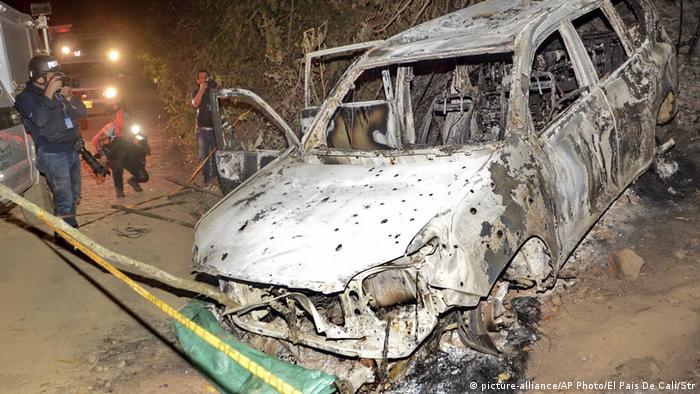On 9. September celebrates Colombia’s national day of human rights, and stresses the progress. In stark contrast, activists and representatives of the indigenous population see themselves as deadly threats.

The destroyed car of a local politician, Karina Garcia.
4000 members of the indigenous population of Colombia have had to leave within six days, their home in the North-East of the country. The background of fierce fighting between armed gangs, the United Nations office for the coordination of humanitarian Affairs (OCHA) reported. The trigger for the clashes of 26. to 31. August should have been “a territorial dispute and the use of anti-personnel mines”.
On the national day of human rights, the Colombian government regularly stresses the exceptionally good progress in this area. But the reality is different. Representatives of the indigenous population, social activists and committed local politicians are currently at the top of the hit list of criminal gangs profiting from the drug trade. The human rights representative of the Colombian government, Francisco Barbosa, repeatedly condemned these murders on his Twitter profile and called enlightenment. On the occasion of human rights day, he placed prominently this Tweet: “Colombia will bend to any blackmail. The government will take action against any group that tries to violate the human rights.”

At the beginning of January were murdered in the space of only six days, six social activists, including Maritza Quiroz
The impotence of the state
Actually, should the rebels for three years, peace between the Colombian government and the FARC. The end of the 52-year-old civil war has left behind in the formerly FARC-controlled areas, however, a power vacuum that could fill the state, neither the military nor in society. Of phase-controlled by the FARC guerrillas for almost a third of the Colombian territory.
Since the conclusion of peace in 2016 criminal gangs, especially the drug mafia, the left rebels of the ELN, and former FARC rebels who reject the peace, the control of territory and the drug trade are fighting now. The state has not, at any time the full control in these areas to recover. The losers will be the people who carry no weapons, and especially those who claim human rights, social activists, journalists, trade unionists and representatives of the indigenous population.
Civil society on the hit list
According to the Colombian NGO for peace research Indepaz members have been murdered since the signing of the peace agreement between the government and the FARC rebels, a total of 566 social activists and 149 former FARC. The confusing number of armed groups in the former FARC areas, the approximately 1800 former FARC militants add to this that rejected the peace process from the start and not disarmed.

The civil society fights back – at the risk of life
The politically motivated murders are mostly in connection with not yet or only inadequately implemented points of the peace agreement. The victims were often for a fairer distribution of land, the return of unlawfully expropriated land ownership, the rights of the indigenous population, or for environmental issues. The campaign for the upcoming local elections in October, exacerbated the danger for committed local politicians and social activists.
Policy is dangerous to life
According to a government study, which was presented last week, is it in a third of all 1100 Colombian municipalities dangerous to life, to engage in political activities. “In 36 percent of the municipalities in the country municipal elections are under threat due to the presence of illegal armed groups”, – said the Ombudsman of the government of Carlos Alfonso Negret at the presentation of the study.
In this context, the particularly brutal murder of Karina Garcia is to be seen. The 32-year-old local politician wanted to be the first mayor of Suarez, a town in the embattled province of Cauca. She entered with her young campaign team for more education and the rights of the indigenous population. The young lawyer died on the first of September in your armored car, together with six other people, including your mother. The car had been attacked with guns and grenades and later fired. Karina Garcia was the mother of a four year old boy.